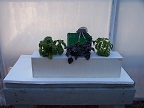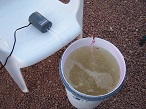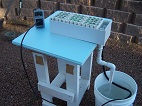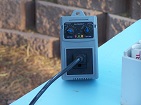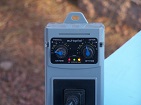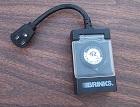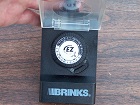Now
that you've built a hydroponic system, you'll surely want to grow
plants in it. Though growing plants in a hydroponic system is quite
easy to do, there are a few other things you will need besides just a
hydroponic system, as well as some things you should know to grow your
plants successfully. Here are some things you'll need, and want to
know about.
Nutrients for Hydroponic Systems
Hydroponic
nutrients are different than nutrients for growing plants in soil. Soil
nutrients don't contain all the micro-elements the plants need. They
don't because the micro-elements are in abundance in the soil, so there
not added to nutrients designed for soil grown plants. You'll need
nutrients designed for growing plants in hydroponic systems. There are
many brands and types on the market to choose from, and most are just
over priced. While liquid fertilizers tend to be easier to use, dry
fertilizers are much cheaper to use because your not paying for the to
ship all that water in the liquid fertilizers to the stores. For more
information about finding economical hydroponic nutrients, and
hydroponic nutrients in general, visit this page;
Nutrients for Hydroponic systemsWhy and when to test and adjust pH in hydroponics
The
plants can only absorb the nutrients in your hydroponic nutrient
solution if the pH of that nutrient solution is within a range the
plants can use. If the pH is out of that range, it won't mater how good
your nutrient solution is, the plants will still suffer from
malnutrition. You should also test pH daily until you are familiar with
how it can change.
pH Test Kits versus Electronic pH test Meters
There
are many different electronic pH test meters on the market. However
good electronic pH test meters expensive and often wind up
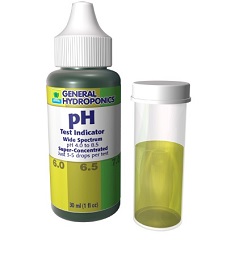
giving you false readings, even if they are calibrated often and
stored properly. General Hydroponics makes very good pH drops (pictured
right).
The pH test drops wont give you false
readings, they don’t need to be calibrated, you don't need to buy
calibration fluid for pH drops, don't need special care to store
properly, and only cost between $6 and $8 depending on where you get
them. Even of you buy an electronic pH test meter, make sure to
have some pH test drops on hand so you can verify the readings your
electronic test meter is giving you if there is any question about it's
accuracy.
Most hydroponic supply stores will want to sell you
the electric meters, and do so saying that they are more accurate, or
the pH drop kits are hard to read. But the truth is you simply don't
need to measure the pH down to the nearest tenth of a point. And they
are very easy to read the results. The plants just need to be within a
range like 5.5 to 6.5, not down to a specific tenth like 6.2. The drops
will last a long time as well, they don't expire. The directions say to
fill the vile ½ way and add 3 drops. But if you just fill the vial
about ¼ inch and use just one drop, you'll get the same color, and
they’ll even last three times longer.
 pH adjusters
pH adjusters
pH
adjusters are what you will need to adjust the pH if it isn’t within
range. Make sure you get pH adjusters designed for hydroponics. Don't
try using pH adjusters for soil, or household products like white
vinegar or baking soda. Anything other than pH adjustors designed for
hydroponics wont be stable, and constantly adding different things to
your nutrient solution is a bad thing. For a list of pH ranges for
different types of plants visit these pages:
Fruit RequirementsVegetable RequirementsHerb RequirementsFlowering plant RequirementsLike
with the nutrients, liquid pH adjustors are more expensive than the
dry adjustors. Both General Hydroponics and Earth Juice make very
good and  inexpensive dry adjustors. A little goes a long way.
Depending on how much you grow and the water quality you use, one
pound of the dry adjustors will probably last you between 6 months to
2 years. Make sure to get both pH up and pH down, even if you don't
think you will need both. There will be times when you over adjust,
and you'll need to bring the pH back the other way.
inexpensive dry adjustors. A little goes a long way.
Depending on how much you grow and the water quality you use, one
pound of the dry adjustors will probably last you between 6 months to
2 years. Make sure to get both pH up and pH down, even if you don't
think you will need both. There will be times when you over adjust,
and you'll need to bring the pH back the other way.
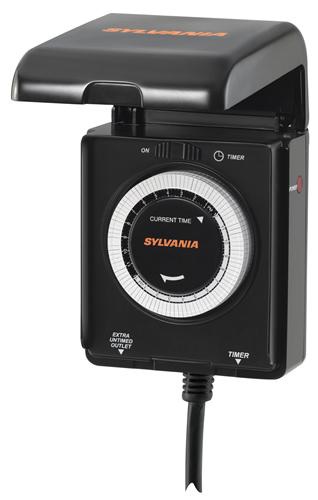 Pump Timers
Pump Timers
Also we would recommend using the
less expensive dial (mechanical) timers, rather than the more expensive
digital timers. Unless your digital timer takes a separate battery to
hold memory when the power goes out. It's happened to us in the past
when even a short 2 second power outage wipes out any memory in the
digital timer, then nothing gets watered, even after the power comes
back on. Besides the possible power outage, the same thing happens
whenever you unplug it for any reason. Like just taking it into the
other room to change the settings. Mechanical timers will just pick
right back up when the power is restored, and don’t have memory to
loose.
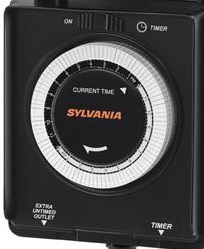 Not
all timers are the same, make sure the one you get has many settings.
Some timers come with only a few pins around the dial. That will
severely limit your options for on/off cycles. We wouldn’t even
consider a timer unless it has pins all the way around the dial like
the one in the picture on the right. Preferably with 15 minute minimum
on/off times rather than the more common 30 minute minimums. 30 minute
minimum on/off time settings will usually be fine, but 15 minute
minimums will give you more flexibility.
Not
all timers are the same, make sure the one you get has many settings.
Some timers come with only a few pins around the dial. That will
severely limit your options for on/off cycles. We wouldn’t even
consider a timer unless it has pins all the way around the dial like
the one in the picture on the right. Preferably with 15 minute minimum
on/off times rather than the more common 30 minute minimums. 30 minute
minimum on/off time settings will usually be fine, but 15 minute
minimums will give you more flexibility.
When you need to use timer for the water pump You'll
need a pump timer for any Ebb & Flow (Flood and Drain) system, Drip
system, Aeroponic system, and sometimes some people use them in NFT
systems as well. Water Culture systems use an air pump which is left
running 24/7 (so no timer is used in water culture systems), and Wick
systems don't use any pumps at all.
For Ebb & Flow, Drip,
and NFT systems the general purposes heavy duty light timers are fine.
While NFT systems don't use a pump timer by definition because the
water is left continuously flowing through the system 24/7. Some
growers still like to use timers in their NFT systems.
For
aeroponic systems true aeroponic system uses high water pressure to
spray a fine mist (around 60-90 psi), and a true aeroponic systems use
a special type of timer called a “cycle timer” that is designed to go
on and off frequently, the timer is usually set to a specific “cycle.”
As an example, it might only be set to go on for 30 seconds, but set to
spray the roots every 5 minutes. So the cycle would be 30 seconds
on, and 5 minutes off, cycling on and off all 24 hours a day like that.
Most people use low pressure in their aeroponic systems. Mainly
because it's much cheaper to use a low pressure pump. If your pump
doesn’t have a psi rating, it's a low pressure pump. You still spray
the roots with spray heads, however they are more like sprinkler heads,
and the water droplet size is much larger because of the lower
pressure. Although you can still use a cycle timer in a low pressure
aeroponic system, a regular general purposes heavy duty light timer can
work as well, as long as it has enough settings. Usually a timer with
pins all the way around the dial, and with 15 minute on/off times. Then
setting it for 15 min on and 15 off all day.
How often to water the plants in your hydroponic system How
often to water the plants in a hydroponic system is one of the most
asked questions. But both the easiest and hardest question to answer at
the same time. Simply because the only real specific answer to that
question that fits every situation is the general rule of thumb, “long
enough to get the roots wet, but not so long they suffocate.”
Everybody’s
situation is different, as well as the type of system their growing in,
how they built the system, type of growing media their using, how much
of it, type of plants their growing, their temperature and humidity
levels etc. etc.. There are just to many variables to give a one size
fits all answer to that question, other than a general rule of thumb.
Most
new growers tend to try and over-think how much to water their plants,
and if they stick to the general rule of thumb (“long enough to get the
roots wet, but not so long they suffocate”), they will be fine. That's
why having a timer that gives you flexibility in your settings is
beneficial.
If the growing media and roots seem to be getting
to dry between watering, increase the frequency that you water them. If
they always seem to be very wet, cut back on your watering times and
see what happens. You can always increase or decrease it again. Every
grower will quickly learn what's best for their situation, type of
system their growing in, growing media, etc., as well as develop their
own preferences. Plants are highly adaptable, so don't over-think it.
Watering
How
often and how long to water is a good question, but has so many
variables like air temperature, water temp, type of growing medium
used, type of plants (do they mind wet feet), how big the plants are,
humidity etc. etc. etc.. That there's simply no real straightforward
answer, except to say the goal is to water long enough to get the roots
(and growing medium) wet, but not so long that the roots suffocate from
lack of air/oxygen. Also to water often enough that they never dry out.
If you see sings of wilting they are either well past dry, or to wet
and suffocating.
Basically speaking, the roots just need
enough moisture that they can absorb enough water to support the plants
foliage. Bigger plants need more moisture (because they have a lot more
foliage to support). Plants growing in dry conditions use more water
than those growing in more humid conditions. Some growing medias hold
moisture much better than others, thus don't need to be watered as
often etc. etc. etc.. So just keep the growing media moist/damp.
Depending
on the time of year (daily highs and lows), for this system I let it
water for 30 minutes on, and between one and two and a half hours off.
Just check the moistness of the growing medium. You will probably want
to try setting the timer for different settings to find what works best
for your plants, as well as your local conditions. Watering at night
(during hours of darkness) is not typically necessary, because plants
only suck up water during light periods. But I typically water a couple
of times during the night in any system anyway, just to keep things
moist
Water level in your hydroponic system The
water level of your hydroponic system will vary depending on the type
of system your growing in, as well as the type of growing media your
using. The type of growing media makes a difference because some will
absorb and hold moisture better than others. In any hydroponic system
the goal is to keep the roots moist, but not let the stem stay wet so
the plant develops stem rot.
Flood and Drain Systems
With
a flood and drain system where the water floods the plants container
from the bottom, you generally want the water level to be about
two inches below the top of the growing media when the system is
flooded. If your using a growing media like rockwool that becomes
saturated easily, you may want it even lower. Basically the very top of
the growing media should be almost dry to avoid stem rot, but a couple
inches down where the plants main root-ball is should be
moist.
NFT Systems
NFT
systems typically just run a continuous thin layer of water along the
bottom of a trough or tube. Just a millimeter or two deep. But
depending on how you set up your NFT system, type of plants, and if
your using much growing media the, your water depth may vary. If the
roots are able to wick up enough moisture to keep the growing media
slightly moist, your fine. But if the the growing media is saturated,
you may need to reduce the water flow through the tube/trough, or tilt
it more to get the water to flow faster. Or even do something to keep
the roots from blocking the water flow through the system.
Drip Systems
The
water depth in a drip system isn’t really a concern because the water
is supposed to drip/trickle down from the top of the growing media to
the bottom of the plant container, then back to the reservoir. So when
working properly, the water never actually builds up in the plants
growing container, the water just moistens the growing media as it
drips downward.
But depending on how you designed your drip
system, and if the roots begin to clog your drain lines, you may get
water pooling in the bottom of the plants container or even overflowing
because it can't drain back properly. Make sure you check your drain
lines regularly for clogging roots. Especially when they get big, and
unclog them before the roots can build up to much. Just a quick
disconnect from the container, then cut and poke through the opening is
all that's needed.
If your plants container is deep enough, an
inch or so of water pooling in the bottom wont be a problem saturating
the growing media. If your concerned about the growing media becoming
saturated from pooling water, you can fill the bottom of the container
with a couple of inches of river rock to aid drainage and keep it from
touching the water in the bottom.
Water Culture systems
In
water culture systems the roots remain submerged under water 24/7, but
not quite all of them. The baskets or cubes holding the plants are
suspended above the water. Usually on floating Styrofoam rafts, or
through holes in a stationary lid of a container. In either case you
want the basket positioned so the growing medium can wick up a little
moisture so it remains slightly moist, but wont become saturated. So
the type of growing media makes a big difference. The splashing of the
air bubbles as they break the surface of the water sprays little water
droplets on the bottom of the baskets/grow cubes. If you have enough
air bubbles going, that should be enough to keep the bottom of most
types of growing media moist without actually touching the water.
The
underwater roots in water culture systems get oxygen from all the air
bubbles from the air pump and air stones in two ways, that way they
wont suffocate. Some of the fresh air bubbles will rise up through the
roots as they rise to the top of the water, in doing so making direct
contact with the roots as they do (the more the better). Also as the
air bubbles rise, they transfer oxygen molecules directly into the
water itself, called “dissolved oxygen” that the plants can absorb
through roots as well.
Aeroponic systems
The
water level in aeroponic systems doesn’t really apply. Basically
because the roots are hanging in mid air, and are never actually
submerged. The timing of how frequently you water the roots so they
never have a chance to dry out is what's important in aeroponic
systems.
Wick Systems
With
wick systems the water level in the plants container doesn’t really
apply, other than you always want the wick to be submerged in water.
Moisture is wicked up into the plants growing container through a wick.
Usually some type of felt fabric. The water never gets a chance to
build up and saturate the growing media. But the moisture level in the
growing media can be controlled. Simply by using a larger or smaller
felt wick, or using more than one to get even more water to wick up.
Also using a good moisture absorbing growing media like coco fiber or
coco chips will aid in moisture retention in wick systems as well.
What size reservoir to use in your hydroponic system Using
the right size reservoir is very important to growing successfully in
hydroponic systems. If your reservoir is to small, that could cause you
a number of problems. So sizing a reservoir for the type of plants your
growing, as well as how many your growing in your system is key. The
general rule of thumb for smaller plants like lettuce or strawberry’s
etc. is a minimum of ½ gallon of nutrient solution per plant in the
system. For larger mid range size plants like herbs or bush varieties
of peppers etc., a minimum of 1 to 1.5 gallons of nutrient solution per
plant in the system. And for large plants like tomato’s, larger
varieties of peppers, melons, cucumbers, squash etc., a minimum of 2.5
gallons of nutrient solution per plant in the
system.
Now
those are just minimum recommendations. We always try and double the
minimum recommendations. You don't need to fill the reservoir all the
way up while the plants are small, but you'll need the full water
volume when the plants get bigger and begin to reach full size.
Starting with a reservoir that will be big enough to begin with is much
easier (and cheaper) than replacing one that is to small with a bigger
one later.
If your reservoir is to small for the plants as
they get bigger, you'll wind up dealing with problems you don't need
to. Problems like large pH swings, needing to replace water to your
reservoir daily as the plants drink it up, constant nutrient
concentration fluctuations, even temperature fluctuations. All of which
can lead plant stress and deficiency’s.
Save
yourself the potential for a lot of headaches, and use a good quality
filtered water from the beginning. Don't underestimate the importance
of the water quality you use for your hydroponic systems, it can make a
big difference in the health of your plants. Tap water, well water,
stream water, rain water all have the potential for problems. Even though water filtered through a water softener is basically pathogen 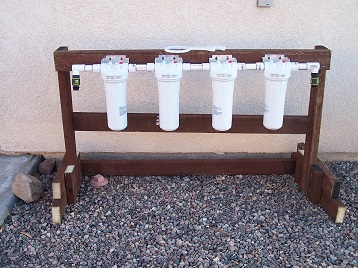 and
bacteria free, as well as most of the dissolved minerals have been
taken out. It has trace amounts of salt (sodium chloride) that is toxic
to plants, even in trace amounts. Some plants will tolerate it better
than others, but the salt will build up in your hydroponic systems over
time.
and
bacteria free, as well as most of the dissolved minerals have been
taken out. It has trace amounts of salt (sodium chloride) that is toxic
to plants, even in trace amounts. Some plants will tolerate it better
than others, but the salt will build up in your hydroponic systems over
time.
Tap water can contain any number of chemicals, minerals,
and even that can build up to toxic levels. It can even have pathogens
and fungi spores in it. Using tap water cause many diseases, mineral
toxicity, and wide pH swings. Rain water can contain all sorts of
pathogens, bacteria, fungi, chemicals from smog, and even 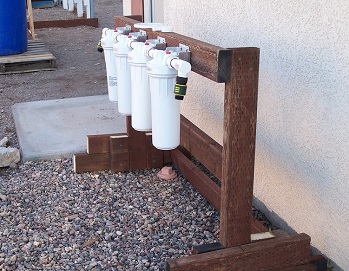 salt
from places near the ocean. Well and stream water not only can contain
all kinds of unwanted minerals, but it also can contain a ton of
microorganisms, soil borne diseases, bacteria and fungi etc. that you
could introduce to your plants. Once you do they can be just about
impossible to get rid of.
salt
from places near the ocean. Well and stream water not only can contain
all kinds of unwanted minerals, but it also can contain a ton of
microorganisms, soil borne diseases, bacteria and fungi etc. that you
could introduce to your plants. Once you do they can be just about
impossible to get rid of.So do
yourself a favor and start with a good quality filtered water to begin
with. RO water would be the best choice. If you don't have a RO system,
then invest in a good water
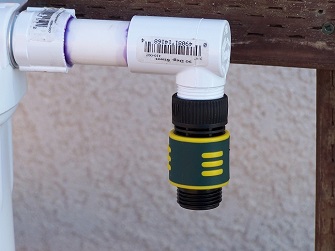
filtration
system. You can even build your own filtration system like we did using
the water filter canisters that take replaceable filter cartridges. We
even added quick connect couplers to make it quick and easy to connect
to the hose when we needed it.
If you do, make
sure to have at least 3 filters. First, a sediment filter. Second, a
activated charcoal filter, Third an "absolute one micron" filter (0.5
microns). The better filters you use, the better your water quality
will be. If you cant afford a filtration system, you can buy water from
the machines at the grocery store. You don't know how often they change
their filters and if they keep up the maintenance on them. But at least
it went through a filtration system and better than the other options.
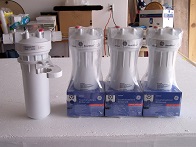
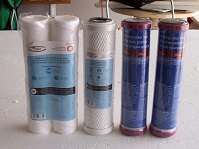
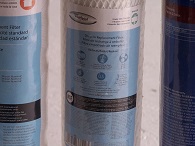
Artificial Lighting used for Hydroponics If
you cant grow your hydroponic plants in natural sunlight, you'll need
artificial lighting to grow them. Electricity isn't free, so we try and
use natural sunlight as much as possible. But if weather conditions,
space issues etc.. prevent you from being able to do so, artificial
lighting would be necessary. There are a wide variety of lighting
available for hydroponic plants. Some being better for some plants, and
other lighting better for others. But that's an entire subject all by
itself, you can find out a lot more about artificial lighting types for
hydroponics, as well as growing plants with them on our page
lights for hydroponic plants.
Water Temperatures and Oxygen for the roots
The
nutrient solution is more than just a simple mix of elements in water
that feed the root systems. It's also part of the environment for the
root system (root zone). The root system environment is just as
important as the above ground environment of the foliage, if not even
more important.
Along with the mineral elements,
the nutrient solution will also contain microorganisms (both good and
bad ones). They get in there both through the air, as well as from
anything that has been placed in it that wasn't sterilized first,
even from your hands. Microscopic microorganisms, bacteria, fungi
spores etc. are on everything and in the air everywhere, and their just
looking for a nice place to grow and multiply (like in your nutrient
solution).
The
optimum water temperature is
between 68 and 72 degrees Fahrenheit. That's optimum, if it's a little
above or below that you should still be fine. When the water (and root
zone) temperature gets in the low 80's and higher, Some negative things
begin to happen. Pathogens (bad microorganisms) like and thrive in warm
water, then they begin to outnumber the good ones. Bacteria and fungi
thrive in warm water as well. Another problem with high water temps is
the plant itself begins to suffer from heat stress, and generally
abort fruiting just trying to stay alive. Also the higher the water
temperature, the less of an ability the water itself has to hold onto
dissolved oxygen molecules. The plant needs to absorb these oxygen
molecules for plant growth, as well not to suffocate. Especially
important in water culture systems where the roots are submerged in the
nutrient solution 24/7.
Using an aquarium air pump with the
air stone in your nutrient solution can help in two ways. First it
replaces the oxygen molecules that the plants absorb. The bigger the
plant the more oxygen the plant absorb, and you can never get to much
oxygen to the root systems. Second is that pathogens are reduced in the
oxygen rich water, but beneficial microorganisms thrive.
Low
water temperatures aren't as bad for your plants, but will stunt and
slow the plants growth. Once the temp gets in the 50's it will become
noticeable, and in the 40's the plants growth gets really slow. If your
water temps are getting to low, you can use an aquarium heater to warm
it up. But make sure it doesn't come in contact with a plastic surface
or it could melt a hole in it, also make sure it remains submerged all
the time. If not, the glass can crack and break.
Happy Gardening!!!

